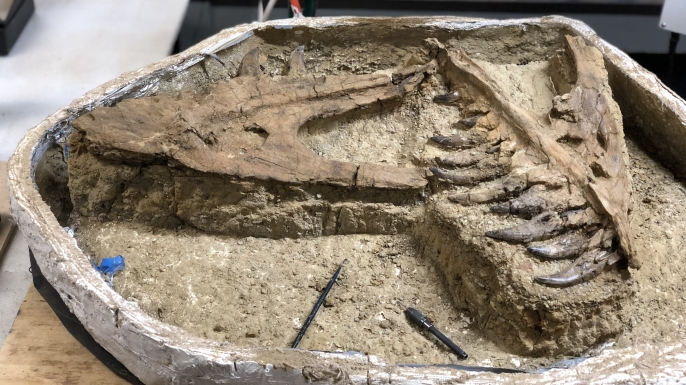In an astonishing discovery, scientists have found out a rare baby tyrannosaur fossil from Montana’s Hell Creek formation. The researchers say that the baby T. rex that they excavated from Montana is a ‘1 in 100 million’ discovery. The researchers and students at the University of Kansas carried out excavation work and also did in-depth research on the well preserved T. rex Dinosaur fossil. According to the researchers, the young Tyrannosaurus rex lived almost 66.5 million years ago.
The baby T. rex had a complete section of the upper jaw with all its teeth intact and also had pieces of its skull, backbones, foot, and hips. Although scientists are sure that the fossil is of a 7-year old T.rex dinosaur still they are not denying the fact that it could be a smaller meat-eating dinosaur. David Burnham, preparator of vertebrate paleontology at the KU Biodiversity Institute said, “The teeth suggest it’s a Tyrannosaurus rex; however, there is still more work to be done. Because a young T. rex is so rare, there are only a few that have been found over the years, so it’s difficult to discern what changes are due to growth or if the differences in the bones reflect different species.”
Kyle Atkins-Weltman, an assistant fossil preparator at the University of Kansas said that young dinosaur fossil is a one in million specimens. It’s because finding a well-preserved young T. rex dinosaur fossil is not so easy and the handful of small dinosaur fossils that have been studied by the scientists are not enough to confirm that they belong to T. rex dinosaurs. Its because the bones or skeletons of the animals grow change shape as they grow and hence confuse the scientists about their evolutionary relationship. For example, the scientists say that the adult dinosaur bone skulls do not look the same as their younger ones.
But the latest young 17-feet long dinosaur fossil is most probably of the baby T. rex, as said by researchers related to the study. A further detailed analysis will make sure whether the fossils are of a young T. rex or a full-grown meat-eating Nanotyrannus. Randal Irmis, a paleontologist at the Natural History Museum of Utah, who was not involved in the study, said that to know whether the specimen is of a baby T. rex, the scientists need to have more similar species to study and there is very less number of juvenile T. rex specimens. “I think the biggest thing is this really shows why it’s important to find multiple specimens of species,” said Irmis. The researchers will be again heading to the spot at Hell Creek this summer to do the field work and search for more of these fossils.
